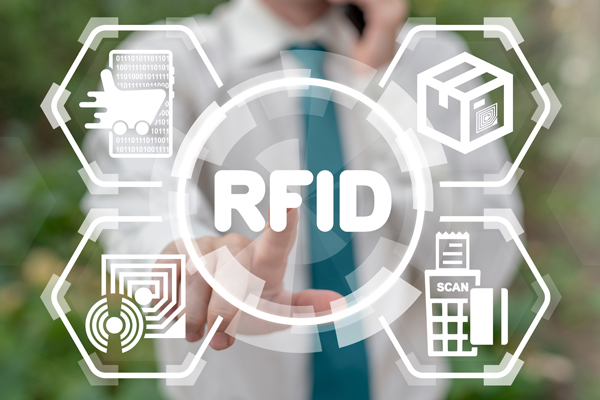RFID in Retail: What It is and How It is Used

Table of contents:
What is RFID
The acronym RFID stands for Radio Frequency Identification. It’s a type of technology that has a similar function as a barcode: it is used to identify objects (or animals, or people). Whereas a barcode is printed on a sticker or product packaging that can be scanned using an optical scanner, RFID uses what’s called an inlay inside a label or plastic tag, and is “scanned” (actually read) by a reader that uses radio waves. RFID labels may look exactly like barcode labels or price stickers.
What kind of information does an RFID label or tag contain? If it’s used for a product (like in retail), it may have the product SKU number or similar information identifying the product as, say, Levi’s jeans, size 34 in indigo blue. RFID is also used for employee badges; those would have your employee number or other identifying information allowing you to open doors at your place of work.
One advantage of RFID over barcodes is that it does not require line-of-sight: the information contained on the RFID tag or label can be read by the reader even if it is covered by something or is inside a box, and it can also be read from a distance. A barcode scanner needs to be pretty close to the barcode label and needs a line-of-sight for its light beam to be able to scan the barcode lines.
How RFID Works
The first step in the lifecycle of an RFID label or tag is to get encoded. A blank label or tag that’s just been manufactured has no information on it. A device called an encoder is used to place the identifying information onto the tag or label using radio or electromagnetic waves. Think of it as saving a number in the label’s or tag’s “memory.” The process takes a second or two.
The label or tag is then placed on a product (or another object) that needs to be tracked. As the product goes through the supply chain, the label can be “read” along its journey, for example, when it leaves the warehouse, when it arrives at the store, or when it exits the store.
How do readers work? They emit a radio or electromagnetic wave that bounces back off the tag or label’s inlay (a small and super-slim electronic piece that looks like a simplified miniature circuit board). The “returning” wave carries to the reader the information stored on the tag or label’s inlay and the reader is then able to identify it.
It should be noted that the information stored on the tag or label is usually just a number, like a SKU or serial number. A separate database will hold more information about the product that matches that number. This could include, for example, its exact size, model, color, price, date of manufacture, etc. The reader will get the number from the label or tag, match it with what’s in the database, and display the result.
The reader can be fixed, like at a checkout counter for example, so a product is simply passed over it. Or it can be handheld, so it is waived over the product.
RFID in Retail: Common Applications
Inventory Tracking with RFID
One of the most useful applications of RFID in retail is to track inventory. For example, when merchandise arrives at the store, RFID readers can be used to read what arrived and update the store’s inventory system. If a fixed RFID reader is used at the door of the stockroom, it can also automatically detect when an employee takes the merchandise from the stockroom and takes it to the showroom, updating the inventory system accordingly. And when the merchandise is sold, scanning it at the checkout can trigger an action to replenish stock so the store does not run out of that product. The obvious benefit of a system like this is to always know what’s in the inventory and to help prevent stockouts.
Tracking inventory at the store level is just one aspect of inventory management, of course. RFID is also commonly used to track what’s coming in and out of the warehouse and where it is being stored. For example, merchandise can quickly be counted using RFID readers as it getting unloaded from a truck arriving from the supplier to the warehouse; it can be scanned with the aisle and bin number where it will be stored, and again it can be counted when it is being loaded onto a truck to be shipped to the store. All these activities can be logged in the inventory system, helping the warehouse management stay up-to-date on the merchandise coming and going.
Cycle Counting with RFID
Many retailers don’t have full-blown RFID systems that can track merchandise on an individual level at the store. The reason often has to do with the cost and complexity of deploying such a system for thousands of different SKUs in hundreds of stores. So, they may still track their inventory the old-fashioned way: by manual counts and using barcodes. Since this is very time-consuming, these retailers will perform full inventory checks only periodically, leading to long periods when the inventory system may not accurately reflect what’s actually in the store. Things do disappear!
A simplified RFID system can help, however – the one that uses just RFID tags, labels, and readers, and sans the database for individual items. Say you have a display of shirts of the same design, and they have RFID labels on them. A store associate can easily wave a handheld RFID reader off the display and instantly count how many shirts are on it. This is called a cycle count and can be performed at the end of every day to verify stock. If at the start of the day the store had 30 shirts, and the POS system says that five were sold, then the reader should be able to count 25 shirts on that display. If there are fewer, that means the store had a loss either from shoplifting, administrative error, or another source. The benefit of cycle counting is to be able to frequently check the stock, not just every once in a while, as is common with manual counts, and to have a more accurate idea of what’s in the store and what left it.
Loss Prevention Using RFID
Retailers commonly use electronic article surveillance (EAS) systems at the doors to detect shoplifting attempts. An RFID system can be used the same way. In fact, RFID antennas designed for store entrances may look exactly the same as EAS antennas, and some incorporate both technologies. An RFID system at the door can detect RFID labels or tags that are leaving the store, and can issue alerts to store associates, just like an EAS system.
Why would a store want to switch to RFID for loss prevention rather than stick with EAS? Retailers that decide to do this are already migrating to wider adoption of RFID for inventory management, so since the merchandise will have RFID tags and labels, why duplicate by also having EAS tags and labels? Another reason may be to stay ahead of the technological curve. EAS systems age and need to be replaced at some point. Rather than replace them with other EAS systems, some retailers replace them with RFID systems because they anticipate a wider use of RFID in their operations in the future, even if it is limited today. When RFID is used to perform EAS functions it is, unsurprisingly, known as RFID as EAS.
Other RFID Uses
Besides the uses described in this article, RFID is used elsewhere to identify things, animals and people. Here are some other common applications:
- ID badge: Your employee ID or access card has an RFID inlay inside identifying you and allowing you to open doors at your place of employment. The device at the door that beeps to let you in is an RFID reader.
- Asset tracking: Used by the military since the 1940s and the private sector more widely since the 1970s, RFID labels and tags can be affixed to any asset that needs to be tracked and counted. This may include tools, supplies or equipment.
- Quality assurance and counterfeit prevention: RFID is commonly used in the pharmaceutical and medical devices industries to track medications, compounds and devices throughout the manufacturing and delivery process to ensure quality and compliance.
- Supply chain management: Similarly to the above point, RFID is commonly used in different types of manufacturing and logistical chains to track individual items as they go through their journey.
- Pets and livestock tracking: When your pet gets “chipped,” that “chip” is actually a tiny RFID tag that identifies your pet. When you “register” that chip, the information about you and your pet is entered into the database that an RFID reader at a vet’s office can look up when your pet’s “chip” is scanned. Farmers also commonly “chip” their heard animals with RFID tags for easier tracking and counting.
- Toll systems: If you use a toll pass device that allows you to pay the toll without stopping or to use a carpool lane, that pass is actually—you guessed it—an RFID tag.
Stay updated with the latest security trends and analyses by following Prosegur's blog.


